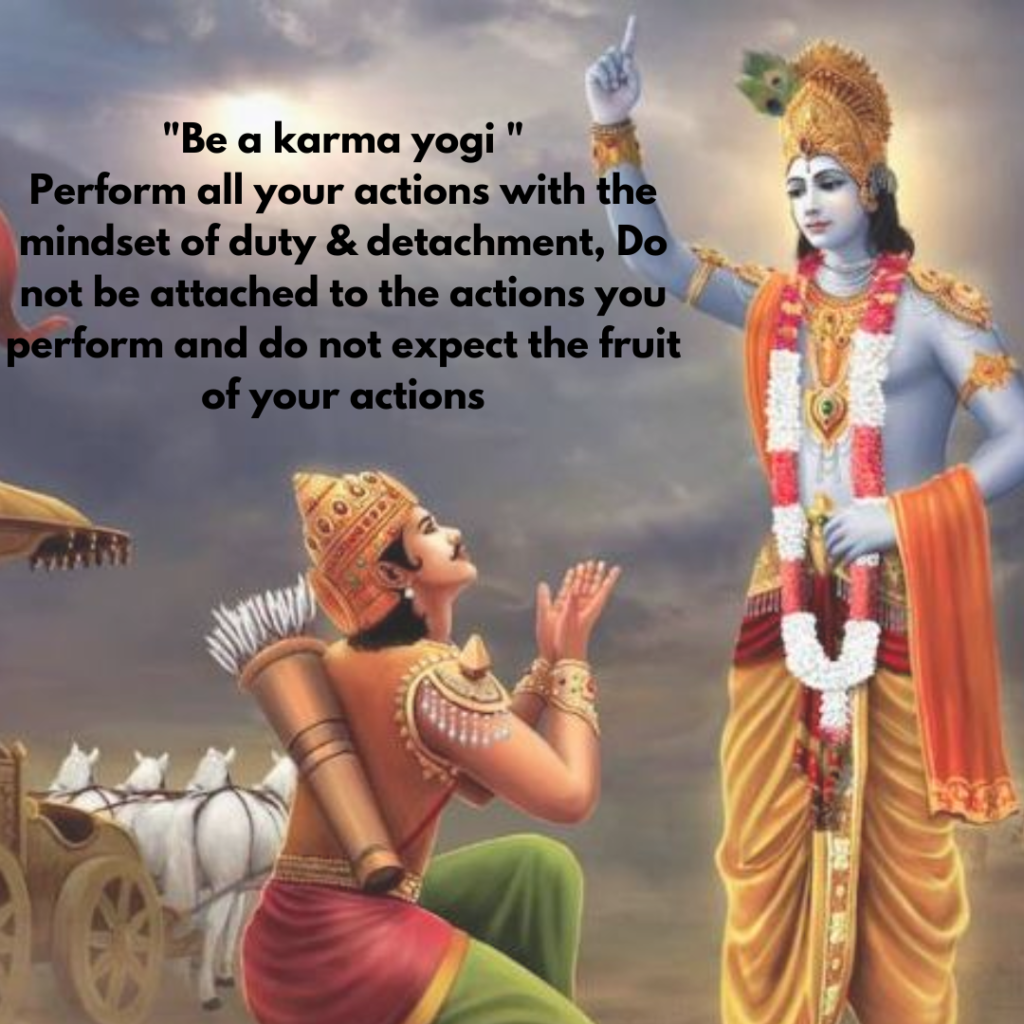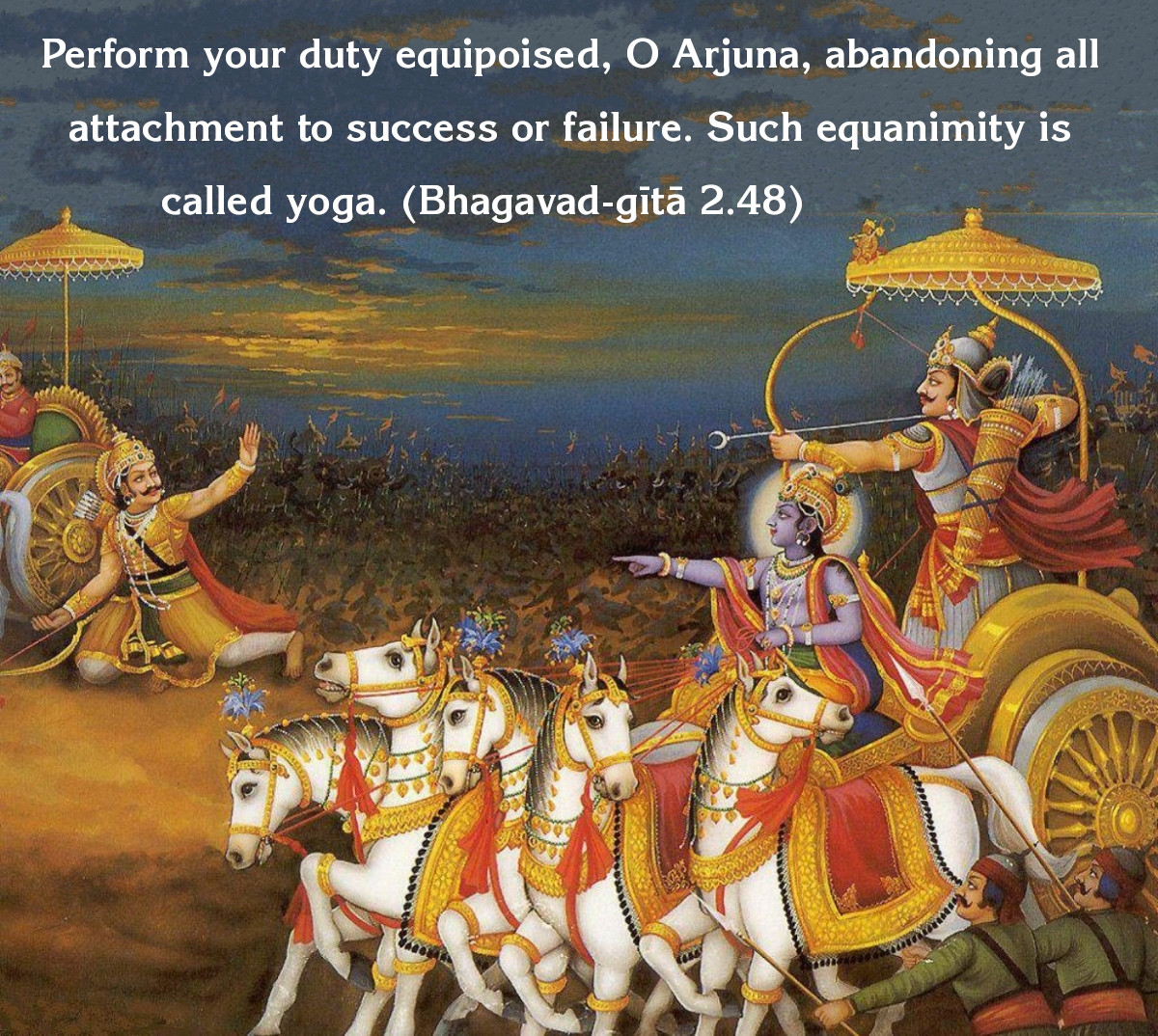The Bhagavad Gita is one of the most revered texts in the Hindu philosophical thought. It contains a dialog between Lord Krishna, who is presented as God incarnate, and the warrior prince Arjuna. The text captures the philosophy, psychology, and practical guidelines on how we can engineer our day-to-day life. The goal of life, as presented in most Hindu scriptures, is to attain Self-realization which is to recognize our true nature as being beyond identification with the mind-body complex.
The Gita contains a variety of concepts and ideas that can help us lead a very purposeful and fulfilling life. These concepts are usually folded into four paths or approaches in life that can help us in our spiritual growth and evolution:
- Karma yoga (path of action)
- Jnana yoga (path of knowledge)
- Bhakti yoga (path of devotion)
- Dhyana yoga (path of meditation)
In the present article, I will try to delve into the salient features of Karma Yoga, referencing key verses from the Gita, that illuminate this path of spiritual growth. The topic of Karma Yoga is discussed in multiple chapters of the Gita. However, in chapter 3 which is entitled “Karma Yoga”, we can get a deep insight into various aspects of Karma Yoga.
Selfless Action: Nishkama Karma
At the heart of Karma Yoga is the principle of niṣkāma karma (निष्काम कर्म), or selfless action. This concept is vividly portrayed in the Bhagavad Gita, wherein Lord Krishna instructs Arjuna to perform his duties as a warrior without any attachment to the outcome. In one of the well-known and oft-quoted verses in the Gita (chapter 2, verse 47), Lord Krishna states:
BG 2.471: Your right is to perform your prescribed duties alone, but never for the results of your actions. Do not become the agent of the results of your action. May you also not have any attachment to inaction.
This teaching underscores that true spiritual progress is achieved not by the results of actions, but by the purity of intention and dedication with which actions are performed.
The three gunas drive all action
The concept of the three gunas – sattva (purity), rajas (action), and tamas (dullness) is discussed in great depth in various chapters of the Gita. Chapter 14 is dedicated fully to this topic.
According to the philosophy of the gunas, everything in nature is a composite of the three gunas. Please read my blog post here for more information on the three gunas.
In the following verses, the Gita highlights that we are driven to action due to the force of these gunas.
BG 3.52: Everyone is forced to act helplessly, driven by the three modes of material nature (the three gunas – sattva, rajas, tamas); therefore no one can refrain from doing something, not even for a moment.
BG 3.273: All actions arise from the three gunas (sattva, rajas and tamas) of Prakriti. One deluded by the ego believes, “I am the doer”.
Detachment: Vairagya
Detachment, or Vairāgya, is another fundamental aspect of Karma Yoga. It involves performing actions without any emotional or egoistic attachment to the action being done or to their expected outcomes. The Bhagavad Gita, in Chapter 3, Verse 19, advises:
BG 3.194: Therefore, without being attached (to the actions or fruits thereof), you should perform your obligatory duty; for by working without attachment, one attains the Supreme.
This detachment helps in maintaining equanimity and inner peace, regardless of success or failure.
In the Yoga Sutras, Patanjali lays a strong emphasis on the value of Vairāgya. He defines two stages of detachment – the lower state (known as ‘para vairāgya’) and the higher state (‘apara vairāgya). Here are the two sutras defining these two stages:
Sutra 1.155 (lower stage): Detachment (vairagya) is the consciousness of perfect mastery in one who has ceased to crave for objects, seen (experienced thru the five senses) or heard about (thru scriptures etc.) (1.15)
Sutra 1.166 (higher stage): The state of supreme dispassion (higher than the one described earlier) is attained when discernment of the Self (purusha) leads to cessation of all craving caused by the three gunas. (1.16)
To read a detailed explanation of these two sutras, please visit my blog post here.
Dharma: Duty and Righteousness
Karma Yoga places a significant emphasis on dharma, or duty. Every individual has specific responsibilities based on their position in life, and fulfilling these duties is seen as a form of worship. The Bhagavad Gita, in Chapter 18, Verse 47, highlights this by stating:
18.477 One’s own duty, even though lacking in merit, is superior to another’s duty well performed. By performing actions as dictated by one’s own nature, one does not incur sin.
Performing one’s duty with dedication and righteousness, without selfish motives, aligns one’s actions with the divine will.
Equanimity: Samatvam
Karma Yoga cultivates equanimity, or Samatvam, a balanced state of mind amidst life’s fluctuations.
BG 2.489: Having established yourself in Yoga, O Dhananjaya (Arjuna), undertake actions, giving up attachment and remaining equipoised in success and failure. Equanimity is called Yoga.
BG 2.3810: Treating pleasure and pain, gain and loss, victory and defeat alike, engage yourself in your duty and fight, thus you will not incur any sin.
By focusing on the action rather than the outcome, and maintaining a balanced perspective, a practitioner can achieve inner harmony.
A Sufi story related to dharma (duty)
A Sufi soldier, in the middle of a battle, came to hand-to-hand combat. Soon he had subdued the enemy down on the ground and raised his hand to drive the dagger down. The enemy in his helpless anger spat on the Sufi soldier’s face. The Sufi soldier’s hand hung in mid-stride and did not strike.
“What are you waiting for? I am totally under your power. Do not torment me any longer. Go ahead, kill me!”—said the fallen enemy, not wanting to prolong his agony.
The Sufi soldier replied: I cannot. “Why?”, asked the enemy. The Sufi replied – Earlier, you were doing your duty and I was doing mine. By spitting on my face, you’ve made me angry. Now, prompted by my ego, killing you will be murder, not an act of duty.
In simple terms, Arjuna is being told to kill but not to commit murder. Arjuna is trained to hit the opponent but inside remain in the center of stillness. That is ahimsa (non-violence) in the battlefield which leads to “actionless action”.
Service to Humanity: Seva
A crucial element of Karma Yoga is the spirit of service, or Seva. Serving others selflessly, without any expectation of reward, is a direct path to spiritual growth. Closely aligned with seva is the concept of charity. The Bhagavad Gita, in Chapter 17, Verse 20, defines ‘sattvic charity’ (charity driven by pure, selfless motive):
BG 17.208: Charity given to a worthy person at the proper time and place, simply because it is right to give, without consideration of anything in return, is stated to be ‘sattvic’ charity (dāna).
This service (seva) can be manifested in various forms, from acts of charity to everyday kindness, acknowledging the presence of divine in all beings.
Purification of the Mind: Chitta Shuddhi
Engaging in selfless actions purifies the mind, reducing selfish desires and ego-driven motivations. The Bhagavad Gita, in Chapter 5, Verse 11, states:
BG 5.1111: The yogis, abandoning attachment, act with body, mind, intellect, and senses only for the purification of the self.
This purification process makes the mind more serene and receptive to higher spiritual truths, gradually dissolving the ego.
Actionless action
Krishna is urging Arjuna to fight the war. However, he also keeps emphasizing that the war must be fought without involving the ego. That way one can maintain a state of equanimity in the face of success or failure, gain or loss, victory or defeat. Let’s look at a few verses that talk about this concept:
BG 4.1712: You must understand the nature of all three types of actions — recommended action, wrong action, and inaction. The truth about these is profound and difficult to understand.
BG 4.1813: One who sees action in inaction and inaction in action is truly wise amongst humans. Although performing all kinds of actions, he is a yogi and master of all his actions.
BG 4.2014: He who gives up attachment to action and their fruits, is independent and ever content; such a person though engaged in activity does nothing at all and incurs no Karmic reaction.
BG 4.2215: He who is contented with whatever gain comes to him, who has passed beyond the dualities, is jealous of none, is equal in failure and success, he is not bound even when he acts.
BG 5.8-5.916 Remaining absorbed in the Self, the knower of Reality should think, ‘I certainly do not do anything’. Even while seeing, hearing, touching, smelling, eating, moving, sleeping, breathing, speaking, releasing, holding, opening and closing the eyes he realizes that the organs are functioning in relation to the objects of the organs.
Integration with Other Paths of Yoga
Karma Yoga often integrates with other paths such as Bhakti Yoga (devotion), Jnana Yoga (knowledge), and Dhyana Yoga (meditation). Each path complements the others, creating a holistic approach to spiritual development. The Bhagavad Gita, in Chapter 5, Verse 4, mentions:
BG 5.417: The wise see that there is no distinction between the paths of knowledge and yoga. Those who apply themselves well in one, obtain the results of both.”
Integrating Karma Yoga in Daily Life
Perform Duties with Dedication
Approach your daily responsibilities — whether at work, home, or in your community — with full dedication and commitment. Focus on the task at hand, putting in your best effort without worrying about the results. This helps cultivate a sense of purpose and excellence in whatever you do.
Practice Detachment from Outcomes (vairagya)
While it is natural to have goals and aspirations, strive to perform actions without becoming emotionally attached to the outcomes. This doesn’t mean being indifferent or unmotivated, but rather maintaining a balanced perspective regardless of success or failure. For instance, if you’re working on a project, focus on doing your best rather than fixating on potential promotion, salary raise, praise or criticism.
Serve Others Selflessly
Look for opportunities to serve others without expecting anything in return. This could be through volunteering, helping a colleague, or simply being kind and supportive to those around you. Acts of service purify the mind and foster a sense of connection with others.
Cultivate Equanimity
Practice maintaining a calm and balanced mind in all situations. Life is full of ups and downs, and maintaining a sense of equanimity helps in handling both with grace. Yoga techniques like a deep sense of awareness, pranayama, and meditation, or simply taking a few deep breaths during stressful moments can help cultivate this mental balance.
View Work as Worship
Treat every action, no matter how mundane, as an offering to the divine. This perspective transforms routine tasks into sacred activities. Whether you are cooking, cleaning, or working on a report, perform these actions with a sense of reverence and devotion. At work, offer your skills and expertise to benefit the organization and your colleagues.
Embrace Continuous Learning and Improvement
Strive for continuous improvement in all aspects of life. Learn from experiences, seek feedback, and look for ways to grow personally and professionally. This approach not only enhances your skills but also aligns with the principle of doing your best in every action.
Maintain a Sense of Gratitude
Cultivate gratitude for the opportunities and experiences life offers, even the challenging ones. Recognizing that each moment is a chance for growth and purification helps in developing a positive outlook and a resilient spirit.
Concluding remarks
Karma Yoga, as elucidated in the Bhagavad Gita and other ancient texts, offers a transformative approach to spiritual growth through selfless action and detachment. By performing one’s duties with a sense of service and without attachment to results, practitioners can achieve inner peace and spiritual liberation. The essential features of Karma Yoga highlighted in this article provide a practical and profound framework for leading a spiritually fulfilling life. Through Karma Yoga, everyday actions become a means of connecting with the divine, fostering a life of purpose and harmony.
Notes:
[1] कर्मण्येवाधिकारस्ते मा फलेषु कदाचन | मा कर्मफलहेतुर्भूर्मा ते सङ्गोऽस्त्वकर्मणि || 2.47 ||
karmaṇyevādhikāraste mā phaleṣhu kadāchana | mā karma-phala-hetur bhūr mā te saṅgo ’stvakarmaṇi ||
[2] न हि कश्चित्क्षणमपि जातु तिष्ठत्यकर्मकृत् | कार्यते ह्यवश: कर्म सर्व: प्रकृतिजैर्गुणै: || 3.5||
na hi kaśhchit kṣhaṇam api jātu tiṣhṭhatyakarma-kṛit | kāryate hyavaśhaḥ karma sarvaḥ prakṛiti-jair guṇaiḥ
[3] प्रकृते: क्रियमाणानि गुणै: कर्माणि सर्वश: | अहङ्कारविमूढात्मा कर्ताहमिति मन्यते || 3.27||
prakṛiteḥ kriyamāṇāni guṇaiḥ karmāṇi sarvaśhaḥ | ahankāra-vimūḍhātmā kartāham iti manyate ||
[4] तस्मादसक्त: सततं कार्यं कर्म समाचर | असक्तो ह्याचरन्कर्म परमाप्नोति पूरुष: || 3.19||
tasmād asaktaḥ satataṁ kāryaṁ karma samāchara | asakto hyācharan karma param āpnoti pūruṣhaḥ ||
[5] Sutra I.15: दृष्टानुश्रविकविषयवितृष्णस्य वशीकारसंज्ञा वैराग्यम्॥१५॥ dr̥ṣṭa-anuśravika-viṣaya-vitr̥ṣṇasya vaśīkāra-saṁjṇā vairāgyam ॥15॥
[6] Sutra I.16: तत्परं पुरुषख्यातेर्गुणवैतृष्ण्यम्॥१६॥ tatparaṁ puruṣa-khyāteḥ guṇa-vaitr̥ṣṇyam ॥16॥
The state of supreme dispassion (higher than the one described earlier) is attained when discernment of the Self (purusha) leads to cessation of all craving caused by the three gunas (1.16)
[7] श्रेयान्स्वधर्मो विगुणः परधर्मात्स्वनुष्ठितात्। स्वभावनियतं कर्म कुर्वन्नाप्नोति किल्बिषम्।।18.47।।
śhreyān swa-dharmo viguṇaḥ para-dharmāt sv-anuṣhṭhitāt | svabhāva-niyataṁ karma kurvan nāpnoti kilbiṣham ||
[8] दातव्यमिति यद्दानं दीयतेऽनुपकारिणे | देशे काले च पात्रे च तद्दानं सात्त्विकं स्मृतम् || 17.20|| dātavyam iti yad dānaṁ dīyate ‘nupakāriṇe | deśhe kāle cha pātre cha tad dānaṁ sāttvikaṁ smṛitam ||
[9] योगस्थ: कुरु कर्माणि सङ्गं त्यक्त्वा धनञ्जय | सिद्ध्यसिद्ध्यो: समो भूत्वा समत्वं योग उच्यते || 2.48|| yoga-sthaḥ kuru karmāṇi saṅgaṁ tyaktvā dhanañjaya | siddhy-asiddhyoḥ samo bhūtvā samatvaṁ yoga uchyate ||
[10] सुखदु:खे समे कृत्वा लाभालाभौ जयाजयौ | ततो युद्धाय युज्यस्व नैवं पापमवाप्स्यसि || 2.38||
sukha-duḥkhe same kṛitvā lābhālābhau jayājayau | tato yuddhāya yujyasva naivaṁ pāpam avāpsyasi ||
[11] कायेन मनसा बुद्ध्या केवलैरिन्द्रियैरपि | योगिन: कर्म कुर्वन्ति सङ्गं त्यक्त्वात्मशुद्धये || 5.11||
kāyena manasā buddhyā kevalair indriyair api | yoginaḥ karma kurvanti saṅgaṁ tyaktvātma-śhuddhaye ||
[12] कर्मणो ह्यपि बोद्धव्यं बोद्धव्यं च विकर्मण: | अकर्मणश्च बोद्धव्यं गहना कर्मणो गति: || 4.17|| karmaṇo hyapi boddhavyaṁ boddhavyaṁ cha vikarmaṇaḥ | akarmaṇaśh cha boddhavyaṁ gahanā karmaṇo gatiḥ ||
[13] कर्मण्यकर्म य: पश्येदकर्मणि च कर्म य: | स बुद्धिमान्मनुष्येषु स युक्त: कृत्स्नकर्मकृत् || 4.18|| karmaṇyakarma yaḥ paśhyed akarmaṇi cha karma yaḥ | sa buddhimān manuṣhyeṣhu sa yuktaḥ kṛitsna-karma-kṛit ||
[14] त्यक्त्वा कर्मफलासङ्गं नित्यतृप्तो निराश्रय: | कर्मण्यभिप्रवृत्तोऽपि नैव किञ्चित्करोति स: || 4.20||
tyaktvā karma-phalāsaṅgaṁ nitya-tṛipto nirāśhrayaḥ | karmaṇyabhipravṛitto ’pi naiva kiñchit karoti saḥ ||
[15] यदृच्छालाभसन्तुष्टो द्वन्द्वातीतो विमत्सर: | सम: सिद्धावसिद्धौ च कृत्वापि न निबध्यते || 4.22||
yadṛichchhā-lābha-santuṣhṭo dvandvātīto vimatsaraḥ | samaḥ siddhāvasiddhau cha kṛitvāpi na nibadhyate
[16] नैव किञ्चित्करोमीति युक्तो मन्येत तत्त्ववित् | पश्यञ्शृण्वन्स्पृशञ्जिघ्रन्नश्नन्गच्छन्स्वपञ्श्वसन् || 5.8|| प्रलपन्विसृजन्गृह्ण्न्नुन्मिषन्निमिषन्नपि | इन्द्रियाणीन्द्रियार्थेषु वर्तन्त इति धारयन् || 5.9||
naiva kiñchit karomīti yukto manyeta tattva-vit | paśhyañ śhṛiṇvan spṛiśhañjighrann aśhnangachchhan svapañśhvasan ||
pralapan visṛijan gṛihṇann unmiṣhan nimiṣhann api | indriyāṇīndriyārtheṣhu vartanta iti dhārayan ||
[17] साङ्ख्ययोगौ पृथग्बाला: प्रवदन्ति न पण्डिता: | एकमप्यास्थित: सम्यगुभयोर्विन्दते फलम् || 5.4||
sānkhya-yogau pṛithag bālāḥ pravadanti na paṇḍitāḥ | ekamapyāsthitaḥ samyag ubhayor vindate phalam ||



Subhash thank for this article on Karma yoga. Very helpful information.
I really enjoyed this on Karma yoga and how to use in our daily lives
Geeta, I am glad you enjoyed the Karma yoga article. It will be great if you could offer any of your own insights about this topic.
Excellent summary of Karma Yoga with practical suggestions. Thank you so much for taking time to share your views on the same in such detail.
Anish, thanks for the feedback. I am so glad that you enjoyed the article.